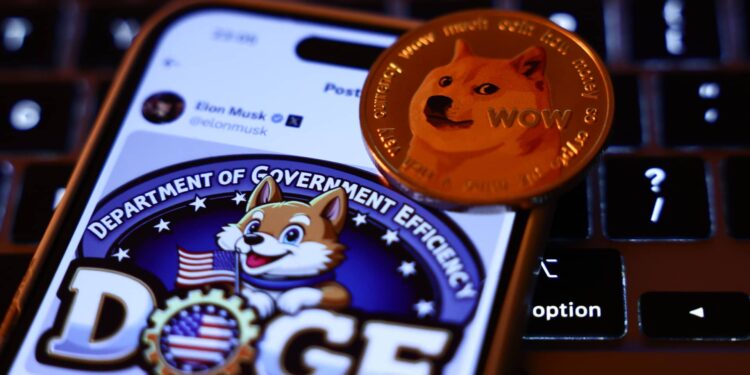Yes, it’s called Fartcoin. Yes, it’s basically pointless.
And yes, its value has skyrocketed over the past week, reaching a market cap of more than $700 million—comparable to companies like Office Depot, Guess jeanswear, and the parent company of Steak N’ Shake.
We’re witnessing a resurgence of the unpredictable and exhilarating world of cryptocurrencies, energized by a broader interest in bitcoin sparked by Donald Trump’s election. This phenomenon is creating new millionaires while risking losses for others. Remarkably, even those who might end up losing are seemingly in on the humor of it all.
This surge of “memecoiners” comprises a mix of seasoned bitcoin holders and folks eager to change their fortunes in an era defined by high property and stock prices, according to Toe Bautista, a research analyst at GSR, a decentralized finance group. Many memecoin investors, riding high on bitcoin’s remarkable 130% boom this year—with nearly 50% of that after Trump’s election last month—are just exploring more speculative avenues. Bautista mentions others are aiming for the impressive possibility of multiplying their investment tenfold overnight.
“A lot of people think they can gain an advantage by treating this like they’re buying a lottery ticket,” Bautista commented.
Buyers and sellers of memecoins are mostly aware they’re engaged in high-risk gambles, Bautista mentioned. The key is to exit positions quickly to avoid being the one left “holding the bag”—the one caught not selling when the price peaks.
“They’re wagering on finding a ‘greater fool,’ someone willing to pay more for their memecoin,” Bautista explained. “The idea is, ‘I got in early, someone will buy it later,’ but there’s no real underlying value to drive its worth.”
The largest threat in memecoin trading, which typically relies on fleeting internet memes, is simply that the meme might vanish from public interest. Substantial returns can occur for a select few during brief news cycles. Blockchain records reveal at least one investor in a coin inspired by last month’s Peanut the Squirrel incident—where a squirrel’s controversial ownership by a New York man led to its demise—has amassed nearly half a billion dollars.
At present, the coin called PNUT has dropped to half its peak value of $2.47 as the news hype has petered out.
However, memecoins also carry operational risks as demonstrated by the brief rise and crash of “Hawk” coin. This coin was launched just earlier this month by Hailey Welch, a Tennessee native who turned a candid street interview into a popular podcast.
Within just one day, Hawk’s market cap surged to $500 million before plummeting to $28 million, sparking complaints about severe financial losses. These complaints haven’t been confirmed by NBC News.
Facing accusations of insider trading, Welch clarified that neither she nor her team had sold any coins, attributing the collapse instead to “sniper” algorithmic bots that aim to immediately sell when prices climb.
Bautista noted that algorithmic trading, a staple in traditional Wall Street trading, is increasingly prevalent among memecoins. He estimates that for the top-20 traded crypto coins, half are memecoins whose trading is largely driven by bots that track and react to price shifts.
Is this legal? Some argue that memecoins remain legal because the Securities and Exchange Commission (SEC) hasn’t classified bitcoin as a security. Despite this, the SEC has taken measures against exchanges allowing trades in various tokens. Critically, many memecoins, Fartcoin included, are not legally purchasable from U.S. exchanges.
At the hub of memecoin launches is a website called Pump.fun, enabling users to instantly create tradeable coins for free. Since its debut in January 2024, the site has generated over $288.4 million in turnover, as per analytics data highlighted by CoinTelegraph, a crypto trade publication.
Earlier this month, the UK’s Financial Conduct Authority declared the website unauthorized in the country and cautioned that engaging with any of its products or services would leave investors unprotected.
Despite this, the site claims its terms are governed by “the laws of England.”
Attempts to reach a spokesperson for comment went unanswered.
Even though the digital landscape may resemble a Wild West, tools are emerging to help less savvy memecoin enthusiasts steer clear of outright fraud. For instance, Rugcheck.xyz offers to analyze memecoin ownership details to assess whether a few individuals might be manipulating the market. Pump.fun itself claims to avert “rugs,” or abrupt price crashes, by ensuring no presales or limited allocations that might benefit insiders in its launched tokens.
The ongoing crypto “bull” cycle might not be done just yet. An analyst suggests it remains in early stages, with potential events in the coming year—lower interest rates by the Federal Reserve and more crypto-supportive policies from the Trump administration—could drive another price rally.
“There are several factors in 2025 that can further boost bitcoin and crypto valuations,” commented Gracy Chen, CEO of Bitget, a crypto firm, during an interview with NBC News.
Indeed, Trump’s circle appears to be strengthening its embrace of cryptocurrencies. Bloomberg News reported that World Liberty Financial—a crypto initiative “inspired by Trump”—has been acquiring millions in tokens beyond just bitcoin, possibly indicating an imminent launch of its decentralized finance platform. Trump himself is mentioned as a potential “financial beneficiary” of World Liberty.
World Liberty’s spokesperson hasn’t responded to requests for comment.
Yet, a dark undercurrent shadows the memecoin realm. Omid Malekan, teaching crypto at Columbia Business School, says it highlights the economic “nihilism” among young Americans who feel shut out from the American Dream.
“These young people see all the good stocks as overpriced. Homes? They’re out of reach,” Malekan explained. “So they turn to gambling on what might ’10x’ their money—and if it all ends in loss, they shrug, feeling they never stood a chance, to begin with.”
















